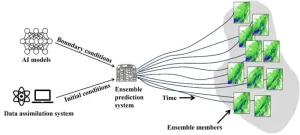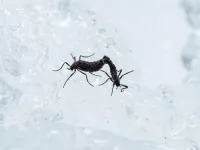(Press-News.org) SAN ANTONIO — February 12, 2025 —Southwest Research Institute (SwRI) scientists are studying Saturn’s moon Titan to assess its tidal dissipation rate, the energy lost as it orbits the ringed planet with its massive gravitational force. Understanding tidal dissipation helps scientists infer many other things about Titan, such as the makeup of its inner core and its orbital history.
“When most people think of tides they think of the movement of the oceans, in and out, with the passage of the Moon overhead, said Dr. Brynna Downey. “But that is just because water moves more freely than anything else. When the Moon passes overhead, the rock is also responding, just less perceptively. But that little bit of gravity that the Moon is imposing is what we call tidal dissipation.” Downey is a postdoctoral researcher at SwRI’s Solar System Science and Exploration Division in Boulder, Colorado and is lead author of a paper on this topic published in the journal Science Advances.
To measure tidal dissipation on the Moon, scientists shoot lasers from Earth at mirrors placed across its surface. This allows them to accurately measure the slightest movement. As this cannot be done on Titan, scientists have instead developed a way to infer dissipation rates based on the difference in Titan’s spin axis rotation from what would be expected absent any such force.
“Tidal dissipation in satellites affects their orbital and rotational evolution and their ability to maintain subsurface oceans,” Downey says. “Now that we have an estimate for the strength of tides on Titan, what does it tell us about how quickly the orbit is changing? What we discovered is that it’s changing very quickly on a geologic timescale.”
Downey and her co-author, Dr. Francis Nimmo of the University of California Santa Cruz, considered that the angle of Titan's spin pole orientation can only be due to friction and deduced a way to relate this angle to a tidal friction parameter. In this way, they were able to deduce some of the history of Titan from its current spin state. With future space missions planned to various moons such as Europa and Ganymede, two moons of Jupiter, Downey hopes that this method can be applied to other moons as well.
Friction in a satellite’s interior causes it to slowly progress toward a circular orbit. At the rate its orbit is changing, Titan should have acquired a circular orbit within about 350 million years. The fact that Titan currently has a noncircular or eccentric orbit implies that something occurred within the past 350 million years that perturbed its orbit.
“Any number of things, such as an impact or loss of an ancient satellite, could have affected the orbit and made it eccentric; our findings are agnostic as to the nature of the event, and others have proposed several options,” Downey said. “The bottom line is that we think something has disturbed Titan's orbit within the last 350 million years, which is relatively recent in solar system history. We are looking at a snapshot in time between that event and the point when it reaches a circular orbit again.”
To access the Science Advances paper “Titan’s spin state as a constraint on tidal dissipation” see https://www.science.org/doi/10.1126/sciadv.adl4741. For more information, visit https://www.swri.org/markets/earth-space/space-research-technology/space-science/planetary-science.
END
Tidal energy measurements help SwRI scientists understand Titan’s composition, orbital history
Saturn moon is slowly recovering from a relatively recent event that affected its orbit
2025-02-12
ELSE PRESS RELEASES FROM THIS DATE:
Data-driven networks influence convective-scale ensemble weather forecasts
2025-02-12
To effectively present the uncertainty of convective-scale weather forecasts, convective-scale ensemble prediction systems have been developed at major operational centers, whose lateral boundary conditions are usually provided by global numerical weather models. Recently, the emergence of AI weather models has provided a new approach to driving convective-scale ensemble prediction systems. AI weather models can produce forecasts for the next 7 to 10 days in just a few minutes, which is around 10,000 times faster than numerical weather models. However, the performance of using the ...
Endocrine Society awards Baxter Prize to innovator in endocrine cancer drug discovery
2025-02-12
WASHINGTON—Donald Patrick McDonnell, Ph.D., has been awarded the Endocrine Society’s John D. Baxter Prize for Entrepreneurship for discovering hormone therapies for treating breast and prostate cancer, the Society announced today.
The John D. Baxter Prize for Entrepreneurship was established to recognize the extraordinary achievement of bringing an idea, product, service, or process to market. This work ultimately elevates the field of endocrinology and positively impacts the health of patients.
McDonnell is a professor at Duke University School ...
Companies quietly switching out toxic product ingredients in response to California law
2025-02-12
A new study by Silent Spring Institute and University of California, Berkeley shows how laws that promote greater transparency around harmful chemicals in products can shift markets toward safer products.
The study, published in the journal Environmental Science & Technology, focused on California’s right-to-know law called Proposition 65, or Prop 65. Under the law, the state of California maintains a list of approximately 900 chemicals known to cause cancer, birth defects, or reproductive harm. Companies that sell products in California are required to warn people if their products could expose them to harmful ...
Can math save content creators? A new model proposes fairer revenue distribution methods for streaming services
2025-02-12
As more consumers turn to subscription-based platforms, the distribution of revenue in streaming services has become a crucial issue in the digital economy. Content creators and artists argue that the current models are opaque, frequently neglecting the needs of creators. In response, researchers at UMH have proposed a model based on three allocation rules that could be applied according to various fairness criteria.
"Our model is based on three main approaches: the equal division rule, which divides revenue equally among services; the proportional rule, which allocates revenue according ...
Study examines grief of zoo employees and volunteers across the US after animal losses
2025-02-12
A collaboration of researchers from Colorado State University and Denver Zoo Conservation Alliance surveyed zoo employees and volunteers across the US about their experiences of burnout and grief related to zoo animal losses.
Their latest study has found that poor grief support in some US zoos leaves staff feeling limited empathy from leadership, burned out, and unable to openly express their grief after the death of an animal to which they had formed a close emotional bond.
The research, published in the journal ...
National study underway to test new mechanical heart pump
2025-02-12
ANN ARBOR, Mich. — A cardiac surgery and heart failure team at the University of Michigan implanted a novel mechanical heart pump into a patient as part of a clinical trial that will compare it to the only device currently used to treat end-stage heart failure.
“This trial presents an opportunity to assess novel technology as we explore a potential new treatment for advanced heart failure — a life-threatening condition with extremely limited therapeutic opportunities available,” said Francis Pagani, M.D., Ph.D., national ...
Antarctica’s only native insect’s unique survival mechanism
2025-02-12
Picture an Antarctic animal and most people think of penguins, but there is a flightless midge, the only known insect native to Antarctica, that somehow survives the extreme climate. How the Antarctic midge (Belgica antarctica) copes with freezing temperatures could hold clues for humans about subjects like cryopreservation, but there remain many mysteries about the tiny insect.
One mystery appears to have been solved by an Osaka Metropolitan University-led international research team. Graduate School of Science Professor Shin G. Goto and Dr. Mizuki Yoshida, a graduate student at the time of the research who is now a postdoc at Ohio State University, found ...
How Earth's early cycles shaped the chemistry of life
2025-02-12
A new study explores how complex chemical mixtures change under shifting environmental conditions, shedding light on the prebiotic processes that may have led to life. By exposing organic molecules to repeated wet-dry cycles, researchers observed continuous transformation, selective organization, and synchronized population dynamics. Their findings suggest that environmental factors played a key role in shaping the molecular complexity needed for life to emerge. To simulate early Earth, the team subjected chemical mixtures to repeated wet-dry cycles. Rather than reacting randomly, the molecules organized themselves, evolved over time, and followed predictable patterns. This challenges ...
Ukraine war forces planes to take longer routes, raising CO2
2025-02-12
Global aviation carbon dioxide emissions increased by 1% in 2023 because planes had to fly longer routes to avoid Russian airspace, according to a new study.
After Russia invaded Ukraine in February 2022, Western airlines were banned from flying over Russia. This forced them to take much longer routes between Europe or North America and East Asia, burning more fuel in the process.
Published today (Wednesday, 12 February) in Communications Earth & Environment, the study found that detours caused by the Ukraine war led to planes using 13% more fuel on average compared to their original routes. The impact was even greater for flights between Europe and Asia, which saw a 14.8% increase in ...
Negative refraction of light using atoms instead of metamaterials
2025-02-12
For the first time, scientists have demonstrated that negative refraction can be achieved using atomic arrays - without the need for artificially manufactured metamaterials.
Scientists have long sought to control light in ways that appear to defy the laws of Nature.
Negative refraction - a phenomenon where light bends in the opposite direction to its usual behaviour - has captivated researchers for its potential to revolutionise optics, enabling transformative technologies such as superlenses and cloaking devices.
Now, carefully ...
LAST 30 PRESS RELEASES:
For teens, any cannabis use may have impact on emotional health, academic performance
School meals could unlock major gains for human and planetary health
Menopause hormone therapy does not appear to impact dementia risk
Signature patterns of brain activity may help predict recovery from traumatic brain injury
Dresden study uncovers new key mechanism in cancer cells
New species are now being discovered faster than ever before, study suggests
Cannabis-based products show limited short-term benefit for chronic pain, with increased risk of adverse effects
Cannabis products with more THC slightly reduce pain but cause more side effects
Clearing the brain of aging cells could aid epilepsy and reduce seizures
Brain injuries linked with potential risk of suicide, new study finds
New technique lights up where drugs go in the body, cell by cell
New study finds movement of fishing fleets can reveal shifts in marine ecosystems
Embargoed: New evidence points to potential treatment for vascular dementia
Study uncovers disrupted brain balance in alcohol dependence
Working in groups can help Republicans and Democrats agree on controversial content moderation online
Structural findings reveal how distinct GPCR ligands create different levels of activation
Anything-goes “anyons” may be at the root of surprising quantum experiments
UC review: Maximizing workplace opportunity for veterans
From generation to complex control: Metasurfaces make perfect vortex beams "within reach"
Thin-film lithium niobate-based detector: recent advances and perspectives
Exploring why some people may tend to persistently make bad choices
How cells balance their protein levels
Nirsevimab vs RSVpreF vaccine for RSV–related hospitalization in newborns
Effectiveness and impact of maternal RSV immunization and nirsevimab on medically attended RSV in US children
AI gives scientists a boost, but at the cost of too many mediocre papers
Next-generation vision model maps tree growth at sub-meter precision
Genes aren’t destiny for inherited blindness, study shows
MIT study: High-fat diets make liver cells more likely to become cancerous
Exposure to multiple fine particulate matter components and incident depression in the US Medicare population
Risk of burdensome health care spending over time in the US
[Press-News.org] Tidal energy measurements help SwRI scientists understand Titan’s composition, orbital historySaturn moon is slowly recovering from a relatively recent event that affected its orbit




